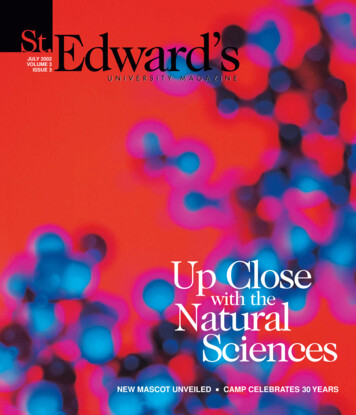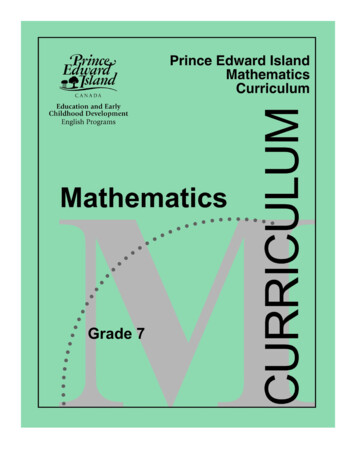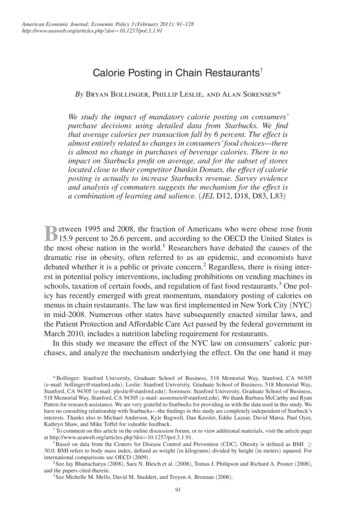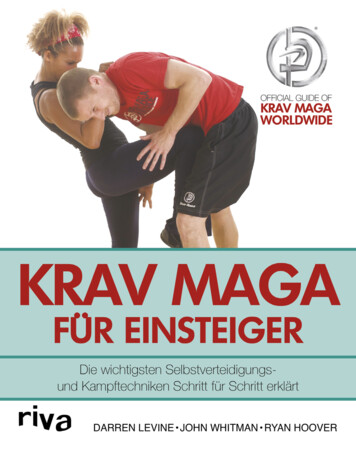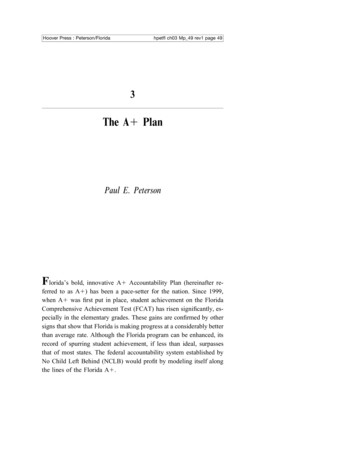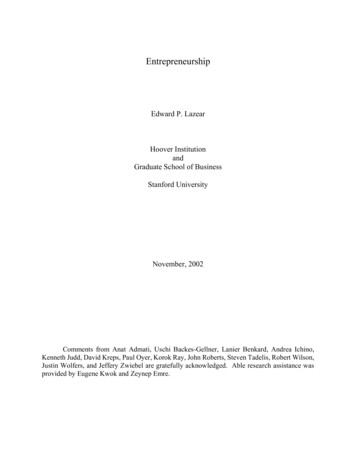
Transcription
EntrepreneurshipEdward P. LazearHoover InstitutionandGraduate School of BusinessStanford UniversityNovember, 2002Comments from Anat Admati, Uschi Backes-Gellner, Lanier Benkard, Andrea Ichino,Kenneth Judd, David Kreps, Paul Oyer, Korok Ray, John Roberts, Steven Tadelis, Robert Wilson,Justin Wolfers, and Jeffery Zwiebel are gratefully acknowledged. Able research assistance wasprovided by Eugene Kwok and Zeynep Emre.
AbstractThe theory proposed below is that entrepreneurs are jacks-of-all-trades who may not excelin any one skill, but are competent in many. A coherent model of the choice to become anentrepreneur is presented. The primary implication is that individuals with balanced skills are morelikely than others to become entrepreneurs. The model provides implications for the proportion ofentrepreneurs by occupation, by income and yields a number of predictions for the distribution ofincome by entrepreneurial status. Using a data set of Stanford alumni, the predictions are tested andfound to hold. In particular, by far the most important determinant of entrepreneurship is havingbackground in a large number of different roles. Further, income distribution predictions, e.g., thatthere are a disproportionate number of entrepreneurs in the upper tail of the distribution, are borneout.
Edward P. LazearEntrepreneurshipNovember, 2002The entrepreneur is the single most important player in a modern economy. Choosing to bean entrepreneur requires an understanding of a variety of business areas. An entrepreneur mustpossess the ability to combine talents and manage those of others. Why do some choose to becomeentrepreneurs and what characteristics create successful ones? What implications does this aspectof occupational choice have for income distribution and for the distribution of talents acrossoccupations? Most of the past work on entrepreneurship has been strictly empirical,1 but it is usefulto have theory to guide the empirics and to assist in interpretation of the results.2It is tempting to argue that the most talented people become entrepreneurs because theyhave the skills required to engage in creative activity. Perhaps so, but this flies in the face of somefacts. The man who opens up a small dry-cleaning shop with two employees might be termed anentrepreneur and the half-million-dollar-per-year executive whose suit he cleans is someone else’semployee. But it would be difficult to find a sensible measure of ability by which the typical drycleaner would dominate the average executive.1See, for example, Evans and Leighton (1989).2The theoretical papers on the subject rarely speak to the issue of occupational choice orresulting income distribution which are central to this paper. For example, Otani (1996)examines the theoretical relation of firm size to entrepreneurial ability. Perhaps the closest tothis paper in terms of discussing specialization (although from a very different point of view) isHolmes and Schmitz (1990) where it is argued that certain agents specialize in entrepreneurialskills. This differs from the approach here, where entrepreneurial skills are implicitly defined tobe a cross section of all possible skills. De Meza and Southey (1996) build a model where newentrants are excessively optimistic.1
Edward P. LazearEntrepreneurshipNovember, 2002Perhaps the situation is the reverse. As necessity is the mother of invention, maybeentrepreneurs are created when a worker has no alternatives. Rather than coming from the top ofthe ability distribution, they are what is left over.3 This argument also flies in the face of some facts.Any ability measure that classifies John D. Rockefeller, Andrew Carnegie, or more recently LarryEllison and Bill Gates near the bottom of the distribution needs to be questioned.The idea explored below is that entrepreneurs differ from specialists in that entrepreneurshave a comparative disadvantage in a single skill, but have more balanced talents that span a numberof different skills. Specialists can work for others who have the talent to spot and combine a varietyof skills, but an entrepreneur must possess that talent. Although entrepreneurs can hire others, theentrepreneur must be sufficiently well-versed in a variety of fields to judge the quality of applicants.To make this vivid, imagine two individuals who are entering the labor market. When theyapplied to undergraduate school, they both obtained total scores of 1200 on their SATs. Oneindividual received a 800 on the quantitative part and a 400 on the verbal part. The other obtaineda 600 on each of the two parts. The theory developed below suggests that the 600/600 individualis more likely to become the entrepreneur than the 800/400 individual.What is an entrepreneur? There are a number of possible definitions. In keeping with theempirical analysis to be performed below, an entrepreneur is defined for this study as someone whoresponds affirmatively to the question “I am among those who initially established the business.”3Landier (2002) argues that the part of the ability distribution from which entrepreneursare drawn may differ across countries and provides a multiple equilibrium approach in aninformation framework to discuss the differences.2
Edward P. LazearEntrepreneurshipNovember, 2002Such individuals, even if they leave the business early, are usually responsible for the conceptionof the basic product, hiring the initial team, and obtaining at least some early financing. Otherdefinitions are possible. For example, CEOs who “reinvent” a company might also considerthemselves entrepreneurs. Conceptually, the model is consistent with including this latter group inthe collection of entrepreneurs, but they will be excluded (with one exception) in the empiricalanalysis. The definition, both at the theoretical and empirical level, is quite distinct from “selfemployed.” A self-employed person need not have any other employees and the kinds andcombinations of skills that are necessary for real entrepreneurship are less important for, say, a selfemployed handyman who works alone.The model presented below is one of occupational choice, where an individual can decidewhether to become an entrepreneur, which makes use of a variety of skills, or to specialize, whichmakes use of one. The model is tested, using data on graduates from the Stanford Graduate Schoolof Business. The data combines information on post-graduate work experience and incomes withcourses taken and grades obtained when the individuals were attending Stanford GSB.The primary theoretical predictions are:1. Individuals with more “balance” are more likely to become entrepreneurs.2. Occupations where the substantive skill and business skills are closer should see a largersupply of entrepreneurs. E.g., insurance and business are closer than sports and business so a higherproportion of insurance agents than sports figures should be entrepreneurs.3. Entrepreneurship should be an increasing proportion of the income bracket in question.4. The supply of entrepreneurs is smaller for production processes that require a higher3
Edward P. LazearEntrepreneurshipNovember, 2002number of independent skills.5.The upper tail of the income distribution is fatter for entrepreneurs than it is forspecialists. Entrepreneurs are predicted to be the highest income individuals in society, but thebottom of the income distribution should have both entrepreneurs and specialists.6.Symmetric underlying ability distributions result in positively skewed incomedistributions.7. Individuals who become entrepreneurs should have a more balanced human capitalinvestment strategy on average than those who become specialists.The predictions are tested empirically using data on Stanford alumni and are borne out.Specifically,1. The most important determinant of becoming an entrepreneur is the number of prior roles(not employers) held. Entrepreneurs are people who are multi-skilled either because of theirendowment or because they acquire skills that they lack.2. Entrepreneurs are disproportionately those who did not take a specialized course loadwhen they were MBA students. Those who become entrepreneurs tended to take a more fielddispersed set of courses.3. Income distributions have fatter upper tails for entrepreneurs than for specialists, althoughthe bottom is similar.4. The proportion of individuals who are entrepreneurs increases with the income bracketexamined.4
Edward P. LazearEntrepreneurshipNovember, 2002A Model of Occupational ChoiceInitially, let there be only two skills, denoted x1 and x2. An individual can be a specialist, inwhich case, he receives income(1) Specialist income max[x1, x2]Entrepreneurs, on the other hand, must be good at many things. Even if they do not do the jobthemselves, they must know enough about a field to hire specialists intelligently. To capture thejack-of-all-trades aspect of entrepreneurship, let(2) Entrepreneur income λ min [x1, x2]where λ is a parameter that is determined in part by technology and in part by market equilibriumthat establishes the value of an entrepreneur. The value of λ, which is called the market value ofentrepreneurial talent, will be derived below. For now, it is sufficient to think of it as a constant thatis given by nature, but in reality it is the product of a technology parameter and a market determinedprice.44This perfect substitutes/perfect complements approach is extreme, but it makes thepoints clear in the easiest possible way. Any production process that has complementarity ofskills for entrepreneurs and substitution of skills for specialists would be consistent with theintuition.5
Edward P. LazearEntrepreneurshipNovember, 2002The initial issue is one of occupational choice. Who decides to become an entrepreneur andwho decides to become a specialist? The decision is straightforward. Think of individuals as beingendowed with a pair of skills (x1 , x2 ). The joint density on x1 and x2 is given by g(x1, x2). Then theindividual chooses to become an entrepreneur if and only if(3)λ min [x1, x2] max [x1, x2]Creativity and willingness to take risk are two factors that are often mentioned as affectingthe decision to become an entrepreneur.5 Creativity is suppressed in this model because it isunobservable. Formally, more creative individuals can be thought of as those with larger values ofλ. They have higher market values for entrepreneurial talent because a given amount of raw skilltranslates into more entrepreneurial output. Risk preference is simply ignored in this model whereeverything other than endowment of x1 and x2 is deterministic.6Who Becomes an Entrepreneur?Let us first explore some of the implications of eq. (3) for the decision to become an5Kihlstrom and Laffont (1979) were the first to argue that entrepreneurs tend to be lessrisk-averse than others in society. Iyigun and Owen (1998) suggest that entrepreneurship is riskyand risk-averse agents are less likely to go into entrepreneurship in a developed economy wherea larger selection of safer (insured) jobs exists.6Becker and Murphy (1992) uses a similar notion of specialization. Becker and Mulligan(2002) apply a technology somewhat like the one in this paper to discuss the difference betweenmarket (specialized) and household (generalized) work.6
Edward P. LazearEntrepreneurshipNovember, 2002entrepreneur. First, it is easiest to see this graphically. A given individual is endowed with x1 andx2, shown as a point in figure 1. For all points below the 45o line, x1 x2 so that a specialist whoseendowment lies below the 45o line would always choose to specialize in x1 and would have incomegiven by x1; x2 is irrelevant to this specialist. In order for that individual to prefer to be anentrepreneur to being a specialist, it is necessary thatλ min [x1,x2] max [x1,x2] ,which here requires thatλ x2 x1because min [x1,x2] x2 and max [x1,x2] x1.Thus, for individuals for points below the 45o line, the condition for entrepreneurship is(4)x 2 x1 / λ.7
Edward P. LazearEntrepreneurshipNovember, 2002This is shown as the shaded area on the diagram between the lines x1 x2 and x2 x1/λ. The areabelow the line x2 x1 /λ corresponds to points where the individual specializes and receives incomex1.Above the 45o line, the converse is true. Here, x2 x1 so the specialist receives income x2.In these cases, the condition for entrepreneurship, thatλ min [x1,x2] max [x1,x2]becomesλ x1 x2so an individual for whom x2 exceeds x1 becomes an entrepreneur when8
Edward P. Lazear(5)EntrepreneurshipNovember, 2002x2 λx1 .This is shown as the cross-hatch area in the diagram. The region in the northwest cornercorresponds to individuals who have sufficiently high values of x2 relative to x1 that it pays for themto specialize in x2 and to receive income x2.The probability of becoming an entrepreneur for any λ is given by the probability that thepair of skills lies in one of the two shaded areas in figure 1 or λ x1(6) prob of entrepreneur λg( x , x )dx dx1221.0 x1 /It is now possible to derive and explain intuitively how occupational choice varies with anumber of different parameters. First, consider λ, the market value of entrepreneurial talent.Differentiate (6) with respect to λ to obtain probx x [ g ( x1 , λx1 ) x1 g ( x1 , 1 ) 12 ]dx1 λλ λ0which is positive.The higher is λ, the more likely is the individual to become an entrepreneur.Diagrammatically, as λ increases the shaded areas become larger because the borders move towardthe axes. If λ were infinity, everyone would become an entrepreneur since for any positive values9
Edward P. LazearEntrepreneurshipNovember, 2002of x1 and x2, entrepreneurial income would be infinite. As λ goes to 1, the shaded areas get pinched.When λ 1, the borders of the shaded area are the line x1 x2 and there are no entrepreneurs.Obviously, if λ 1, it is impossible for condition (3) to hold since the min of something can neverexceed the max of that same thing.7This result is important for equilibrium. The market value of entrepreneurial talent, λ, is aparameter that determines the supply of entrepreneurs in an economy. As λ rises, everyone choosesto become an entrepreneur. As λ falls to 1, no one opts for entrepreneurship. This will guarantee aninterior solution for λ and will ensure that there is a finite number of individuals wanting to enterentrepreneurship.The technological aspect of the λ variable lends itself to a number of interpretations. In somefields, agency problems are pronounced and the technological component of λ is low because it isdifficult to transform raw ability into entrepreneurial skills. In these fields, if you want it done,you’d better do it yourself. In other fields, management is possible because monitoring is less costlyand specialization can be orchestrated more easily. Economies of scale may also be important indetermining λ. In some industries, it may be that raw skills can be transformed into high levels ofentrepreneurial output because technology allows one skilled manager to leverage his talents.It is also possible to think of λ as being person specific. Some individuals have acomparative advantage in entrepreneurship. This might relate to creativity or other skills, but it is7The interpretation is also correct when min[x1, x2] is negative. Then, using one’s talentsas an entrepreneur destroys output and individuals are charged for this. The larger is λ, the moreoutput destroyed and the less likely is the individual to become an entrepreneur.10
Edward P. LazearEntrepreneurshipNovember, 2002reflected in high values of λ. Since such talents are generally unobservable, not much more is saidabout the idiosyncratic variation in λ.8Balance:There is another related result. The smaller is the difference between x1 and x2 for any givenindividual, the more likely is he to become an entrepreneur. To make this more precise, think of anindividual who has total skill X. The more evenly divided X is between x1 and x2, the more likelythat the individual becomes an entrepreneur. The individual becomes an entrepreneur when (3)holds. Rewrite (3) as(3')λ min [x1, X-x1] max [x1,X- x1]If x1 X/2 , then entrepreneurial income is x1 and specialist income is X - x1 . An increase in x1toward X/2 raises the l.h.s. of (3') and lowers the r.h.s. of (3') making entrepreneurship more likely.Conversely, if x1 X/2, then entrepreneurial income is X-x1, which decreases in x1 and specialistincome is x1. Lowering x1 toward X/2 raises the likelihood that the individual will choose to be an8One of the skills can be interpreted as the ability to raise capital. This argument iscentral to Evans and Jovanovic (1989). Holtz-Eakin, Joulfaian, and Rosen (1994) show thatcapital is important in starting a business by linking the receipt of an inheritance to the likelihoodof starting a business. Recent work by Gentry and Hubbard (2002) explores the relation ofsaving to entrepreneurial investment. Their motivation is growth and macroeconomic factors,but the results are relevant to this study as well. They find that there is an interdependencebetween entrepreneurial saving and investment.11
Edward P. LazearEntrepreneurshipNovember, 2002entrepreneur. For a given X, the maximum likelihood that the individual chooses to be anentrepreneur occurs when x1 x2 X/2.The point is that entrepreneurs are balanced individuals. They must be almost equallytalented in a number of different areas. The idea that balance is important suggests that the supplyof entrepreneurship may vary by industry. For example, those endowed with great artistic talent arenot likely to be also endowed with great business skills. As long as both artistic and business skillsare relevant for production in the art business, then few will have high enough levels to avoidspecializing in one or the other aspect of the business. Thus, the supply of entrepreneurial talent inart would be expected to be low, so most artists must be managed by others. The prediction is thatthere would be very few artists who run their own studios and publicize their own work.An alternative example involves insurance agencies. The ability to understand complexinsurance policies is a skill that is likely to be correlated with the accounting and management skillsnecessary to run a business. As a result, there are many who are well-suited to running their ownagencies and so the number of agencies should be great and their average size small.In the context of figure 1, the supply of entrepreneurs is greater for any given λ when mostof the points lie close to the 45o line. Individuals whose endowments are near the line x1 x2 aremore balanced.The empirical statements are verifiable by looking at real world data.9 In situations whereentrepreneurs are rare, a few must run the whole industry, driving up concentration ratios. In9To make statements about groups, it is necessary to show that the propositions are truein a statistical sense at the level of the population. This is derived in the appendix.12
Edward P. LazearEntrepreneurshipNovember, 2002situations where many opt to be entrepreneurs, the concentration ratios should be low. Of course,other technological considerations are key here and must be held constant. If scale economies aremore important in some industries (e.g., automobiles) than in others (e.g., restaurants), theconcentration ratios are likely to be higher in the former than the latter, independent ofentrepreneurial supply considerations.Ability Levels:At the outset, it was suggested that there are entrepreneurs at all income and ability levels.The model presented suggests some patterns that may be observable in real world data. Inparticular, entrepreneurship should be more prevalent among higher income individuals. Theintuition is easily obtained by examining a special case of figure 1 shown as figure 2.Here, the joint density of x1, x2 is such that all points lie within the box bounded by (0,0),13
Edward P. LazearEntrepreneurshipNovember, 2002(1,0), (1,1) and (0,1). Now suppose that we stratify a sample of individuals on the basis of theirincome. A specialist can never have income greater than 1 because sup {max[x1 , x2 ]} 1 .Entrepreneurs can have income greater than 1 because their minimum skill is multiplied by themarket value of entrepreneurial talent, λ, to obtain income. For example, an individual with x1 1and x2 1 would have income of λ, which exceeds 1.In fact, there are three ways to have income equal to 1. An individual can have x1 equal to1 and specialize in x1, he can have x2 equal to 1 and specialize in x2, or he can be an entrepreneur.This is shown by the thick saw-tooth iso-income line that joins 1 on the x1 axis with 1 on the x2 axis.The same is true for other levels of income, e.g., I0 and I1, which reflect two more among the family14
Edward P. LazearEntrepreneurshipNovember, 2002of iso-income lines.Clear from figure 2 is that irrespective of the income brackets or of the underlying densityfunctions, at least at the top income brackets (for income 1), all individuals are entrepreneurs. Atlower levels of income, some individuals must be specialists so at least at the extremes, there mustbe a rising proportion of entrepreneurs with income levels.10The result follows in this example. It is possible to reverse it by making sufficient extremeassumptions about the distribution of underlying talents and the demand for entrepreneurs. Forexample, suppose that max(x1) 100, max(x2) 1 and that the demand for entrepreneurs is such thatλ 99. Then the only individuals with income between 99 and 100 are specialists with very highlevels of x1.This example is anomalous for two reasons. First, it requires asymmetries between x1 andx2. Second, it ignores the fact that the situation described is self-correcting in that it tends to inducea high level of λ. When very few have high values of both x1 and x2, the supply of entrepreneurs islow, which drives up the equilibrium price of entrepreneurial skills.Complexity of Production:Some production processes are very complex, requiring many skills in order to produceoutput. Others are relatively straightforward. As the world has become complex, a larger varietyof skills may be required to be an entrepreneur. In an agrarian society, a farmer did not require too10The production functions guarantee this result. Less restrictive production technologieswould also produce this result.15
Edward P. LazearEntrepreneurshipNovember, 2002many business skills to run his small farm and get his produce to market. The founders of themodern corporation are a different breed. They are more than competent technicians; they mustunderstand how to create a worldwide business.What happens to the supply of entrepreneurs as the number of factors increases? Withoutbeing more specific about the distribution of the factors, it is impossible to make qualitativestatements. However, it is possible to show that the introduction of independent factors alwaysreduces the supply of entrepreneurs.Consider the original joint density g(x1,x2). Now introduce a third factor, x3, and let thedensity of the three be denoted k(x1,x2,x3). If x3 is an independent factor with (marginal) densitym(x3), then it is possible to writek(x1,x2,x3) m( x ){ g( x , x )dx dx }dx312213The condition necessary to ensure an entrepreneur for two variables must still hold. For any givenx3, the projection onto the x1, x2 plane does not lie in the entrepreneurial area, the individual will notchoose to be an entrepreneur. That is, ifλ min[x1,x2] max[x1,x2] ,the individual becomes a specialist, irrespective of x3. In addition, there are some potential cutoffvalues, x3* and x3**, that are also required for entrepreneurship. So the probability of being anentrepreneur cannot exceed16
Edward P. LazearEntrepreneurshipx3**November, 2002 λ x1 m( x ){ λg( x , x )dx dx }dx31x3*22130 x1 /which can be written as λ x1{ M ( x ) M ( x )} **3*3 λg( x , x )dx dx12210 x1 /Since the first term cannot exceed 1, the probability of being an entrepreneur cannot be higher withthree factors than with two, and in general must be lower.The proof can be repeated, adding one factor at a time.Therefore, the supply ofentrepreneurs falls as the production process requires more independent skills. One implication isthat the supply of entrepreneurs should decline over time as few individuals have high enough levelsof all skills to choose to be entrepreneurs, which should also imply increasing premiums toentrepreneurship.1111Thus, the difference between the earnings of a Silicon Valley entrepreneur and hisemployees should exceed the difference between the earnings of a 19th century farm owner andhis hired hands.17
Edward P. LazearEntrepreneurshipNovember, 2002The Distribution of IncomeThe model presented above has a number of implications for the observable distribution ofincome. There are some measurement problems that camouflage some of the results, but let us putthose aside for now and derive the implications of the pure model in the absence of complicatingfactors.It is interesting to examine the distribution of income among specialists, amongentrepreneurs, and the overall distribution of income that does not distinguish between them.12Minimum and Maximum Income:The maximum income for an entrepreneur occurs on the 45o line in figure 1. Since thebinding constraint is always the lowest income, for any x1 or x2, income can never be higher thanitis for the corresponding value of the other factor on the 45o line. Let x1 and x2 be defined overintervals x1L # x1 #x1U and x2L # x2 # x2U. Then, the maximum income among entrepreneurs isλ x1U if x1U x2Uandλx2 if x1U x2UThe maximum specialist income depends only on the maximum of either x1 or x2. Thus, the12Hamilton (2000) shows that entrepreneurs have lower initial earnings than nonentrepreneurs. He attributes this to a compensating differential for being able to be one’s ownboss.18
Edward P. LazearEntrepreneurshipNovember, 2002maximum income among specialists isx1 if x1U x2Uandx2 if x1U x2UBecause λ 1, a sufficient condition for the maximum income of entrepreneurs to exceed themaximum income of specialists is that x1U x2U . This is not a necessary condition. As λ goes toinfinity, the maximum income among entrepreneurs must exceed that among specialists, for anyfinite x1U, x2U .A similar analysis can be done for minimum income. Because an individual will not choosean occupation unless the income is higher there than in the other occupation, with a sufficiently largenumber of individuals in the population, the minimum for both groups must be the same. To see thismore formally, note that for a sufficiently large population, there exists an individual whose valuesof x1 , x2 lie within an epsilon neighborhood of x1L , x2L for arbitrarily small epsilon. Nowsuppose that x1L x2L . Then the minimum specialist income would be x2L if there were not theentrepreneurial option. There are two cases. The worst entrepreneurial option may be worse thanthe worst specialist option. This occurs when λ x1L x2L . Then the lowest specialist income isindeed x2L because the lowest x1 , x2 individual chooses to be a specialist. But that is also the lowestentrepreneurial income because no one would choose to be an entrepreneur unless x1 weresufficiently high that λx1 x2L. Minimum income for the specialist equals that for the entrepreneur.19
Edward P. LazearEntrepreneurshipNovember, 2002In this case, the minimum income for each group is x2L . In the second case, the worstentrepreneurial option is better than x2L. Then the minimum entrepreneurial income is λ x1L x2L. But then individuals will not choose to specialize unless x2 is sufficiently high to equal the incomeof an entrepreneur. Once again, minimum income for the specialist equals that for the entrepreneur,only this time the minimum is λ x1L.Summarizing, the maximum income for entrepreneurs under general conditions is higherthan that of specialists, but the minimum income of both groups is the same.Observed income may be different than that predicted, especially for very low levels andvery high levels. There are two reasons. Self-employed individuals have wages that reflect notonly human capital, but physical capital. When starting a business, reported income is negativebecause the self-employed person takes his “wage” and invests it, along with other capital, directlyinto the business. In a mature business, the reverse is true. What shows up as wage is in part areturn on human capital, but in part a return on the physical capital that the individual invested inearly. Wage and salary workers separate the earnings and investment. They take their earnings,which are always non-negative and then invest it in physical capital. Even if the total investmentexceeds their wage, the wage still shows up as a positive number. Second, there is likely to be alarger transitory component in the earnings of the self-employed, especially at very high and verylow earnings. Some of this can be dealt with by averaging earnings over a longer period of time,or ideally, computing lifetime wealth, which is really the variable to which the theory speaksdirectly.20
Edward P. LazearEntrepreneurshipNovember, 2002Average Income:There is no general proposition that can be stated on the relation of average income amongthe entrepreneur to that of specialists. The results are distribution specific. What can be said,however, is that numerical methods reveal the following.13If x1 .and x2 are distributed normally and independently, then it is always true that meanentrepreneur’s income exceeds mean specialist income, for any value of λ. The difference betweenthe means is increasing in λ as is clear because entrepreneurial income goes to infinity as λ goes toinfinity.The same logic implies that for any distribution of x
The entrepreneur is the single most important player in a modern economy. Choosing to be an entrepreneur requires an understanding of a variety of business areas. An entrepreneur must possess the ability to combine talents and manage those of others. Why do some choose to become entrepreneurs and what characteristics create successf ul ones?

